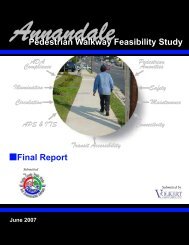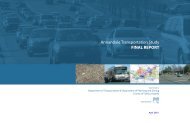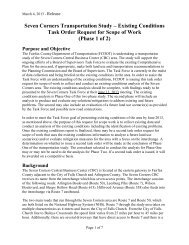2050 Eastern Gateway Concept Plan - City of Falls Church
2050 Eastern Gateway Concept Plan - City of Falls Church
2050 Eastern Gateway Concept Plan - City of Falls Church
Create successful ePaper yourself
Turn your PDF publications into a flip-book with our unique Google optimized e-Paper software.
Goals<br />
The goals for the future transportation network in the study<br />
area seek to address the issues described above. The goals are<br />
multi-faceted and aim to address the needs <strong>of</strong> the existing<br />
community as well as newcomers to the study area, the need to<br />
provide smooth circulation to facilitate economic development,<br />
and sustainability concerns related to the local environment,<br />
economy, and social equity. These goals are meant to serve as<br />
a general starting point and may be expanded with future<br />
public input or direction from city staff as specific plans are<br />
proposed within the study area. The fundamental transportation<br />
goals for the proposed development at the <strong>Falls</strong> <strong>Church</strong> <strong>Eastern</strong><br />
<strong>Gateway</strong> are as follows, not listed in any priority order:<br />
Goal 1: Minimize traffic congestion resulting from the proposed<br />
development.<br />
Goal 2: Move people and goods efficiently.<br />
Goal 3: Meet the transportation needs <strong>of</strong> long-time <strong>Falls</strong> <strong>Church</strong><br />
residents as well as the new residents, employees, and tourists<br />
that come to the study area as a result <strong>of</strong> the proposed<br />
development. Such transportation solutions will focus on local<br />
transportation services within the study area, with connections to<br />
regional services.<br />
Goal 4: Coordinate land use and transportation planning to<br />
accommodate the transportation needs resulting from the level<br />
<strong>of</strong> development proposed for each site within the study area.<br />
Goal 5: Minimize negative impacts to air quality as a result <strong>of</strong><br />
the proposed development and its associated transportation<br />
impacts.<br />
Goal 6: Promote a multi-modal transportation system that is<br />
socially equitable and economically and environmentally<br />
sustainable.<br />
Strategies<br />
Each strategy described below may help meet several <strong>of</strong> the<br />
proposed transportation goals. Some <strong>of</strong> the strategies are<br />
already in use today, but there is a need to expand these<br />
efforts and perhaps focus them for the study area. For<br />
example, those who currently work in <strong>Falls</strong> <strong>Church</strong> may use the<br />
ridesharing services provided through the Metropolitan<br />
Washington Council <strong>of</strong> Government’s existing Commuter<br />
Connections program. When the study area is built out and has<br />
a high concentration <strong>of</strong> employees commuting from various<br />
parts <strong>of</strong> the D.C. region, a ridesharing program specific to the<br />
study area may be warranted. Such a program could<br />
potentially be run through the city, through individual<br />
employers, or through coordinated efforts between employers<br />
within the study area. This example demonstrates that the<br />
transportation strategies already in place today may also be<br />
effective in achieving transportation goals in the future.<br />
These strategies vary in how difficult they are to implement, the<br />
associated costs <strong>of</strong> implementation, and their potential impacts





